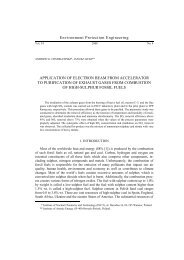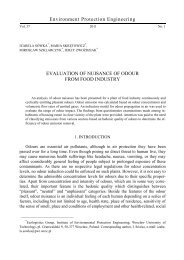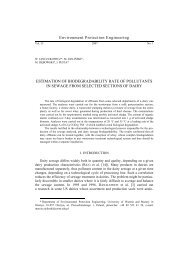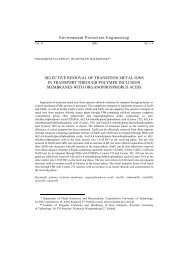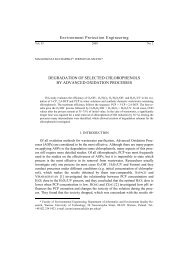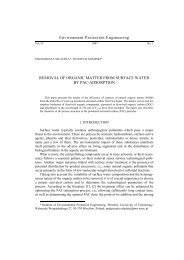Removal of pertechnetate ion from radioactive waste using anion ...
Removal of pertechnetate ion from radioactive waste using anion ...
Removal of pertechnetate ion from radioactive waste using anion ...
Create successful ePaper yourself
Turn your PDF publications into a flip-book with our unique Google optimized e-Paper software.
122<br />
H. INOUE et al.<br />
3. RESULTS AND DISCUSSION<br />
−<br />
TcO 4 fluxes through both the paper and polymer membranes were increased with<br />
an increase in the concentrat<strong>ion</strong> <strong>of</strong> the phase I (figure 2A-1), while Cl – fluxes through<br />
both the paper and polymer membranes were not influenced by increasing concentrat<strong>ion</strong><br />
<strong>of</strong> the phase I (figure 2A-2). The net fluxes <strong>of</strong> and Cl – through the<br />
paper membrane were almost by two orders <strong>of</strong> magnitude greater than those through<br />
the polymer membrane as shown in figures 2A-1 and 2A-2. The paper membrane can<br />
absorb about 450 times more water per dry weight than the polymer membrane as<br />
shown in the table. Moreover, the mean pore size <strong>of</strong> the paper membrane ranges approximately<br />
<strong>from</strong> 1 to 5 μm (as estimated <strong>from</strong> micrographical measurements), while<br />
that <strong>of</strong> the polymer membrane is less than 1 nm (as indicated by the manufacturer).<br />
Hydrated radii <strong>of</strong> the permeating <strong>ion</strong>s, and Cl – , are almost equivalent <strong>of</strong> 3.5 Å<br />
and 3.0 Å, respectively [10], [11]. Therefore, and Cl – −<br />
TcO4<br />
−<br />
TcO4<br />
−<br />
TcO4<br />
−<br />
TcO4<br />
<strong>ion</strong>s in the paper membrane<br />
can be transported more freely than those within the polymer membrane as<br />
shown in figures 2A-1 and 2A-2.<br />
100<br />
Flux / 10 10<br />
-<br />
16 -2<br />
mol m<br />
s -1<br />
1<br />
0.1<br />
10<br />
Flux /<br />
10<br />
1<br />
0.1<br />
-6 mol<br />
m -2 s -1<br />
100<br />
C 10<br />
1<br />
m Total /<br />
10 -14 mol<br />
kg -1<br />
TcO4 -<br />
A B<br />
1 1<br />
TcO4 -<br />
Cl -<br />
0.01<br />
0 10 20 30 40 50 60<br />
TcO4 - Radioactivity <strong>of</strong> phase I / kBq<br />
2<br />
0.1<br />
10<br />
C 1<br />
m Total /<br />
mol kg -1<br />
0.1<br />
Cl -<br />
0.01<br />
0 10 20 30 40 50 60<br />
TcO4 - Radioactivity <strong>of</strong> phase I / kBq<br />
Fig. 2. Intercompartment <strong>ion</strong> flux (A) and its concentrat<strong>ion</strong> (mol g –1 -dry membrane)<br />
in membrane phase (B) as a funct<strong>ion</strong> <strong>of</strong> the TcO radioactivity <strong>of</strong> phase I. Upper frames (1)<br />
and lower frames (2) indicate flux and concentrat<strong>ion</strong> <strong>of</strong> TcO and Cl – −<br />
4<br />
− , respectively.<br />
4<br />
Circles and triangles denote paper membrane and polymer membrane, respectively<br />
2



